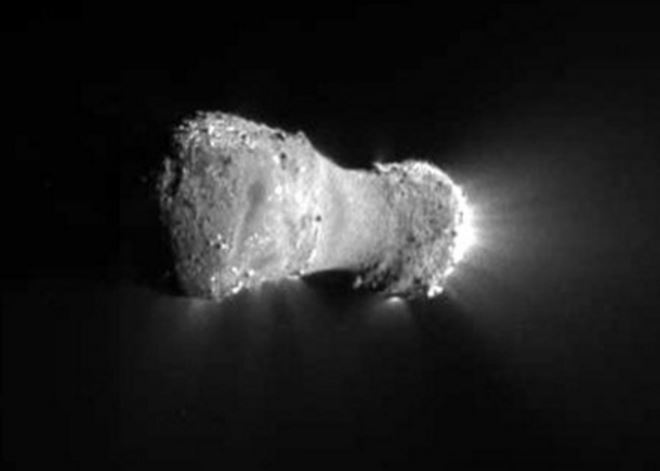Giant comets could destroy life on Earth at any moment and are a much greater threat to our existence than asteroids, says a team of scientists from the University of Buckingham in England and Armagh Observatory in Northern Ireland, especially since hundreds of centaurs (giant comets) have been discovered in the outer planetary system over the past twenty years.
Professors Duncan Steel, Professor of Astrobiology at the University of Buckingham, England and Astronomer at the Armagh Observatory; Bill Napier, Honorary Professor at the Buckingham Centre for Astrobiology; Professor Mark Bailey and Dr. David Asher from Armagh Observatory, published a review of their research in the latest issue of the Royal Astronomy Society’s journal Astronomy & Geophysics.
The centaurs move on unstable orbits, crossing the paths of Neptune, Uranus, Saturn and Jupiter – the outer planets. These planets’ gravitational fields can sometimes pull giant comets towards the Earth.
 Giant comets (centaurs) are big and come in various shapes. Because they are so far away from the Earth, they appear as pinpricks of light in even the largest telescopes. (Image: news.sciencemag.org. Credit: NASA)
Giant comets (centaurs) are big and come in various shapes. Because they are so far away from the Earth, they appear as pinpricks of light in even the largest telescopes. (Image: news.sciencemag.org. Credit: NASA)
Centaurs are really big
Centaurs are enormous comets, usually from 50 to 100 kilometres (31 to 62 miles) across – some are even larger. Just one of them contains more than the combined mass of all the Earth-crossing asteroids found to date.
The scientists calculated that the chances of a giant comet being deflected by the gravitational pull of one of the outer planets directly towards Earth come to about one major impact every 40,000 to 100,000 years.
While in near-Earth space, these large objects are expected to disintegrate into dust and fragments, spreading across the inner solar system with debris, which would make impacts on Earth inevitable.
According to what geologists and archeologists know about the history of our planet, plus our ever-increasing knowledge of interplanetary matter in near-Earth space, a giant comet’s fragment struck our planet about 30,000 years ago.
This centaur would have strewn the inner planetary system with fragments ranging in size from particles of dust to lumps several miles across.
Specific occurrences of environmental upheaval about 10,800 BCE and 2,300 BCE, identified by palaeontologists (fossil scientists) and geologists, also confirm our new understanding of cometary populations.
 The outer solar system as we recognise it now. The Sun is at the centre of the map, and closest to it the tiny orbits of the terrestrial planets (Mercury, Venus, Earth and Mars). In bright blue you can see the near-circular paths of the giant planets: Jupiter, Saturn, Uranus and Neptune. The orbit of Pluto is shown in white. Staying perpetually beyond Neptune are the trans-Neptunian objects (TNOs), in yellow: seventeen TNO orbits are shown here, with the total discovered population at present being over 1,500. The orbits of 22 Centaurs (out of about 400 known objects) are shown in red, and these are essentially giant comets. Their orbits are unstable. (Image: www.ras.org.uk)
The outer solar system as we recognise it now. The Sun is at the centre of the map, and closest to it the tiny orbits of the terrestrial planets (Mercury, Venus, Earth and Mars). In bright blue you can see the near-circular paths of the giant planets: Jupiter, Saturn, Uranus and Neptune. The orbit of Pluto is shown in white. Staying perpetually beyond Neptune are the trans-Neptunian objects (TNOs), in yellow: seventeen TNO orbits are shown here, with the total discovered population at present being over 1,500. The orbits of 22 Centaurs (out of about 400 known objects) are shown in red, and these are essentially giant comets. Their orbits are unstable. (Image: www.ras.org.uk)
Mass extinctions linked to giant comets
There have been some mass extinctions in Earth’s history, such as the death of the dinosaurs sixty-five million years ago. They may similarly be linked to this giant comet hypothesis.
Regarding our study of asteroids, comets and giant comets, Prof. Napier said:
“In the last three decades we have invested a lot of effort in tracking and analysing the risk of a collision between the Earth and an asteroid. Our work suggests we need to look beyond our immediate neighbourhood too, and look out beyond the orbit of Jupiter to find centaurs.”
“If we are right, then these distant comets could be a serious hazard, and it’s time to understand them better.”
 What happened to the dinosaurs could happen to us if a giant comet fragment hits Earth.
What happened to the dinosaurs could happen to us if a giant comet fragment hits Earth.
The scientists have also uncovered evidence from several different fields of science that backs up their model.
For example, there are sub-millimetre craters found in lunar rocks which the Apollo programme brought back to Earth which are nearly all younger than 30,000 years. This suggests that since then there has been a vast increase in the amount of dust and fragments in the inner Solar System.
Citation: “Centaurs as a hazard to civilization,” Bill Napier, David Asher, Mark Bailey and Duncan Steel. Astronomy and Geophysics. December 2015. DOI: 10.1093/astrogeo/atv198.
Video – Scientists warn about giant comets hitting Earth

